处于可检测阈值的暴力
原文标题:Violence at the Threshold of Detectability
作者:Eyal Weizman
翻译:小饰
April 2015
Negative Positivism
消极的实证主义
The new millennium began with a bizarre legal battle. The David Irving trial, which unfolded at the English High Court of Justice between January and April 2000, involved one of the most aggressive cross-examinations of architectural evidence—drawings, models, aerial and ground-level photographs—ever undertaken in a legal context. The case unfolded around a libel suit filed by David Irving against an American writer and her publisher, Penguin Books, for calling him “the most dangerous of all holocaust deniers and a falsifier of history.”1 Awkwardly, the process forced the veracity of claims on both sides to be put on trial, and crucially not by means of historical narration, but by subjecting the accusations to legal rules of evidence. On the tenth and eleventh days of the trial, January 26 and 27, the legal debate revolved around the architecture of one of the gas chambers—an underground structure that was part of Crematorium II in Auschwitz-Birkenau. One detail emerged as central to this debate. Irving, representing himself, focused his cross-examination of the expert witness facing him—architectural historian and Auschwitz expert Robert Jan van Pelt—on four small holes in the ceiling of the concrete roof of the structure.2 According to the few surviving witnesses—both victims and perpetrators—it was through these holes that the cyanide poison coming out of canisters labeled “Zyklon-B” would enter a room packed with thousands of people.
千禧年以一场怪异的法律斗争开始。2000年1月至4月在英国高等法院进行的大卫-欧文审判,涉及有史以来在法律背景下对建筑证据--图纸、模型、空中和地面照片--进行的最积极的交叉质询之一。该案围绕大卫-欧文对一位美国作家及其出版商企鹅出版社提起的诽谤诉讼展开,该出版社称他是 "所有大屠杀否认者中最危险的人,是历史的伪造者。"1尴尬的是,这一过程迫使双方主张的真实性受到审判,而且关键是不通过历史叙述的方式,而是通过将指控置于法律证据规则之下。在审判的第10天和第11天,即1月26日和27日,法律辩论围绕着其中一个毒气室的建筑展开--这个地下建筑是奥斯威辛-比克瑙第二火葬场的一部分。有一个细节成为这场辩论的核心。欧文代表自己,对他面对的专家证人--建筑历史学家和奥斯威辛专家罗伯特-扬-范佩尔的盘问集中在该结构混凝土屋顶天花板上的四个小孔上。2根据少数幸存的证人--包括受害者和肇事者--正是通过这些小孔,从标有 "齐克隆-B "的罐子中流出的氰化物毒药进入挤满数千人的房间。
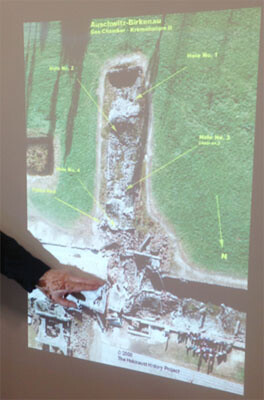
Robert Jan van Pelt points to the ruins of Crematorium II in Auschwitz-Birkenau. The gas chamber is on top and the arrows indicate the probable location of the holes in the ceiling.
Van Pelt’s expert report, submitted to the court before the session began, conceded that “these four small holes … cannot be observed in the ruined remains of the concrete slab,” but explained that verification was impossible due to the state of the roof. The roof slab broke, twisted, and folded in on itself in the explosion that was meant to eliminate its use as evidence, and has only disintegrated in the fifty-six years since. Traces of the holes were discovered a few years later,3 but in 2000, the court heard the following exchange:
罗伯特-扬-凡-佩尔特指着奥斯威辛-比克瑙第二火葬场的废墟。毒气室在上面,箭头表示天花板上的洞的可能位置。
范佩尔在开庭前提交给法庭的专家报告承认,"这四个小孔......在混凝土板的废墟中无法观察到,"但他解释说,由于屋顶的状况,无法进行验证。屋顶板在那场旨在消除其证据用途的爆炸中断裂、扭曲并折叠在一起,在此后的五十六年中只是解体了。几年后发现了洞的痕迹,3但在2000年,法庭听到了以下交流。
Irving: And you do accept, do you not, that if you were to go to Auschwitz the day after tomorrow with a trowel and clean away the gravel and find a reinforced concrete hole where we anticipate it would be from your drawings, this would make an open and shut case and I would happily abandon my action immediately?Van Pelt: I cannot comment on this. I am an expert on Auschwitz and not on the way you want to run your case.Irving: There is my offer. I would say that that would drive such a hole through my case that I would have no possible chance of defending it any further.4
欧文:你是否接受,如果你后天带着小铲子去奥斯威辛,清理碎石,发现一个钢筋混凝土的洞,我们从你的图纸上预计它将在那里,这将使案件公开化,然后我会很乐意立即放弃我的行动?我不能对此发表评论。我是奥斯威辛的专家,而不是你想办案的方式。这就是我的提议。我想说的是,这将使我的案件出现巨大的漏洞,我将没有可能再为它辩护。
Irving’s line of argument proposed that without these holes, the cyanide poison could not have been introduced into the room, and the room thus could not have functioned as a gas chamber. If the structure was not a gas chamber, then indeed Auschwitz could not have been a death camp. Without Auschwitz as the functional and symbolic center of the extermination process, the Holocaust, as a premeditated policy of industrialized racially motivated killing, could never have happened. “No holes no holocaust,” as another negationist already proposed5; and if it didn’t happen, Irving could not be accused to be the falsifier of history—quod erat demonstrandum!
欧文的论点是,如果没有这些孔,氰化物毒药就不可能被引入房间,因此该房间不可能作为毒气室使用。如果这个结构不是一个毒气室,那么奥斯威辛确实不可能是一个死亡营。如果没有奥斯威辛作为灭绝过程的功能和象征中心,大屠杀,作为一种有预谋的工业化种族动机的杀戮政策,就不可能发生。"没有漏洞就没有大屠杀",另一位否定论者已经提出5;如果它没有发生,欧文就不能被指控为历史的伪造者--quod erat demonstrandum!
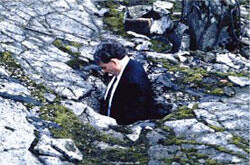
Fredrick Töben, an Australian holocaust denier, fits himself through a break in the roof of Crematorium II at Auschwitz-Birkenau. He is trying to demonstrate that a particular opening was too large to have been one the lethal holes.
澳大利亚否认大屠杀的人弗雷德里克-托本(Fredrick Töben)通过奥斯威辛-比克瑙二号火葬场屋顶的一个破口将自己装进去。他试图证明一个特定的开口太大,不可能是一个致命的洞。
The use of material evidence to contradict survivors’ testimony had already been an established method used by Holocaust deniers. Witness testimony, they claimed, produced “too much metaphysics, not enough materialism.”6 However, it was not simple positivism that led deniers to insist on materiality, but rather a desire to preclude the very ability of witnesses to speak to history at all. By posing matter against memory, they demanded a history without subject and beyond language. In Irving’s legal strategy, the fact that the holes could not be found became “negative evidence” against the process of extermination. Negative evidence is an oxymoronic term that legal scholars use in order to refer to an absence of material evidence that they want to be considered as evidence in itself.7 It is what defense teams mobilize to disrupt prosecution cases: no body, no gun, no holes. In legal terms, it is a kind of antibody that comes to disrupt and dismantle complex epistemological assemblages of networked evidence. Furthermore, given that a hole is not matter, but a gap within material continuity, the issue at stake was not a simple absence but a certain “absence of an absence.” Throughout the trial, Irving also seemed obsessed by the metaphorical power of holes: “I am going to keep on driving holes in this case until your Lordship appreciates the significance of the holes, or their absence.”8
使用物质证据来反驳幸存者的证词,已经是大屠杀否认者使用的一种既定方法。他们声称,证人的证词产生了 "太多的形而上学,而不是足够的唯物主义。"6 然而,导致否认者坚持物质性的不是简单的实证主义,而是希望排除证人对历史发言的能力本身。通过将物质与记忆对立起来,他们要求一个没有主题和超越语言的历史。在欧文的法律策略中,找不到洞的事实成为反对灭绝过程的 "负面证据"。消极证据是一个矛盾的术语,法律学者用它来指没有物质证据,但他们希望将其本身视为证据。在法律术语中,它是一种抗体,来破坏和拆除复杂的网络证据的认识论组合。此外,鉴于洞不是物质,而是物质连续性中的一个缺口,所涉及的问题不是一个简单的缺席,而是某种 "缺席的缺席"。在整个审判过程中,欧文似乎也为洞的隐喻力量所困扰。"我将继续在本案中打洞,直到法官大人理解洞的意义,或洞的缺失"。
Harun Farocki’s 1988 film Images of the World and the Inscription of War presented an inadvertent prequel to this story. On August 25, 1944, a US reconnaissance mission was sent to photograph a petrochemical factory—Monowitz-Buna—next to the Auschwitz-Birkenau extermination camp. The five-by-three miles of territory captured in a single 35mm negative included the roof of Crematorium II, somewhere close to the edge of the frame in the lens’ area of parallax distortion. The discovery that this image, along with a few other aerial photographs from the spring and summer of 1944, contained photos of the crematorium took place only in 1978, when they were found by two CIA image analysts named Dino Brugioni and Robert Poirer. When enlarged, Brugioni and Poirer spotted four blurry marks on the roof of the crematorium building and annotated them as “vents.”9
哈伦-法罗基(Harun Farocki)1988年的电影《世界的影像和战争的铭文》为这个故事呈现了一个无意中的前传。1944年8月25日,一个美国侦察团被派去拍摄奥斯威辛-比克瑙灭绝营旁边的一个石化工厂--莫诺维茨-布纳。在一张35毫米的底片中拍摄到的五乘三英里的区域包括二号火葬场的屋顶,在镜头的视差失真区域中靠近画面边缘的某处。这张图片和其他几张1944年春夏的航拍照片中包含火葬场的照片是在1978年才被发现的,当时这两张照片是由两位名叫迪诺-布鲁吉奥尼和罗伯特-波尔勒的中央情报局图像分析员发现。放大后,布鲁吉奥尼和波尔勒发现火葬场建筑物的屋顶上有四个模糊的标记,并将其注释为 "通风口 "9。
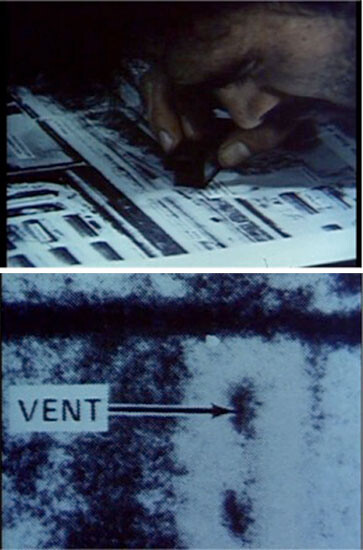
Harun Farocki, Images of the World and the Inscription of War, 1988. The pattern interruption on the image of the vents is a result of printing. The image was filmed from a print. For the photographic interference pattern please see the following images.
Irving claimed that the four marks could not be the four holes in the roof. They had a strange interference pattern, he said, and suggested that the negative had been tampered with by the addition of “brush strokes.”10 Already familiar with such arguments from negationist literature, Van Pelt presented a report prepared by Nevin Bryant, supervisor of image processing applications at NASA’s Jet Propulsion Laboratory in Pasadena and an expert in the analysis of aerial and satellite images. While the CIA analysts were enlarging the negatives with the analogue optics available at the end of the 1970s, Bryant used state-of-the-art digital magnification to peer into the “molecular composition of the film.” At stake was the way in which concrete elements got recorded by the silver halide crystals, the very chemical composition of a film, with about fifteen thousand feet of atmosphere in between. From this altitude and at the resolution of the specific negative used by the US Air Force, a single grain represented an area about of about half a meter squared on the ground.
欧文声称,这四个标记不可能是屋顶上的四个洞。他说,这些痕迹有一种奇怪的干扰模式,并表明底片被篡改过,被加上了 "画笔"。10 范佩尔从否定论的文献中已经熟悉了这种论点,他提出了一份由Nevin Bryant编写的报告,NASA在帕萨迪纳的喷气推进实验室的图像处理应用主管,是航空和卫星图像分析方面的专家。当中央情报局的分析人员用1970年代末的模拟光学设备放大底片时,布莱恩特用最先进的数字放大镜来窥视 "胶片的分子组成"。关键是具体的元素如何被卤化银晶体记录下来,这正是胶片的化学成分,中间有大约一万五千英尺的大气层。从这个高度和美国空军使用的特定底片的分辨率来看,一个颗粒代表了地面上大约半米见方的区域。
Bryant suggested that the interference pattern, identified by Irving and other negationists, is a phenomena that can occur on the level of the grains in the emulsion of the film when single objects on the ground are at, or close to, the size of a single silver salt particle in the film.11 He first noticed a similar process in a small section of another photograph that was on the same roll of negatives (a reconnaissance plane shoots a fast automatic sequence of photographs along its flight path). This section of the image captured a group of prisoners being marched within the camp. Irving similarly referred to this representation of prisoners as “brush strokes.” Responding to the judge’s request for clarification, Van Pelt repeated Bryant’s conclusion: the interference pattern is caused when “the size of a head of a person is the same as the size of a grain in the the emulsion of the film, and the result of that was that a moiré effect, which occurs also in the newspaper when you photograph a picture which has been screened twice.”12
布莱恩特提出,由欧文和其他否定论者确定的干扰模式是一种现象,当地面上的单个物体达到或接近胶片中单个银盐颗粒的大小时,就会在胶片乳剂中的颗粒层面上出现。11 他第一次注意到,在同一卷底片上的另一张照片的一小部分也有类似的过程(一架侦察机沿其飞行路线拍摄快速自动序列的照片)。这段照片拍摄了一群囚犯在营地内行进的情景。欧文同样将这种对囚犯的表现称为 "笔触"。在回答法官的澄清要求时,范佩尔重复了布莱恩特的结论:当 "人头的大小与胶片乳剂中的颗粒大小相同时,就会产生干扰图案,其结果就是摩尔纹效果,当你拍摄一张经过两次筛选的照片时,在报纸上也会出现这种效果 "12。
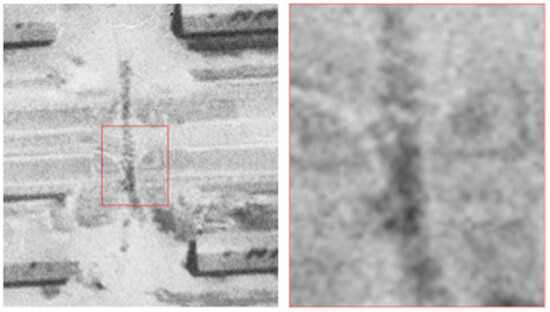
A group of prisoners is marched through Auschwitz. US Air Force, August 25, 1944. The size of the head of a single prisoner on the ground is the size of s single silver salt particle in the film. Courtesy of Nevin Bryant (NASA).
The size of the hole in the roof of Crematorium II was approximately the size of a person as seen from above. The hole was thus approximately the size of a silver salt grain. When an object photographed approximates the recording ability of a negative, it is in a condition that we can refer to as the threshold of detectability. In this condition, the materiality of the object represented (the concrete roof/hole) and the materiality of the surface representing it (the surface of the negative/silver salt grains) should be considered both as presence and as representation. Each surface must be equally analyzed as an image and as a material reality.
一群囚犯在奥斯威辛集中营行进。美国空军,1944年8月25日。地上一个囚犯的头的大小是影片中s个银盐颗粒的大小。由内文-布莱恩特(NASA)提供。
二号火葬场屋顶上的洞的大小,从上面看,大约是一个人的大小。因此,这个洞大约是一个银盐颗粒的大小。当被拍摄的物体接近底片的记录能力时,它处于一种我们可以称为可检测阈值 的状态。在这种情况下,所代表的物体(混凝土屋顶/孔)的物质性和代表它的表面(底片/银盐粒的表面)的物质性都应该被视为存在和代表。每一个表面都必须被平等地分析为图像和物质现实。
A certain inversion also occurred: the concrete roof was analyzed as a recording device, while the molecular surface of the negative was seen as a material composition of silver crystals.13 The photograph of the roof was thus a photograph of a photograph.
As the cross-examination went on, it became clear that against the linear argument mobilized by Irving’s negative evidence, Van Pelt had woven a complex and overwhelmingly convincing network of converging evidence, both for the existence of the holes on the surface of the negative as well as for its existence within the broken concrete surface.14
Irving lost the case, and my aim is not to reopen it. What we should take from this story, as we move on, is the problems of violence at the threshold of detectability.
还出现了某种反转:混凝土屋顶被分析为一个记录装置,而底片的分子表面则被视为银晶体的物质构成13。
随着盘问的进行,很明显,针对欧文的底片证据所调动的线性论证,范佩尔编织了一个复杂的、具有压倒性说服力的证据网络,既证明了底片表面的小孔的存在,也证明了它存在于破碎的混凝土表面。
欧文败诉了,但我的目的不是要重开这个案子。更进一步,我们应该在这个故事中注意的是的是小孔可检测性带来的暴力问题。
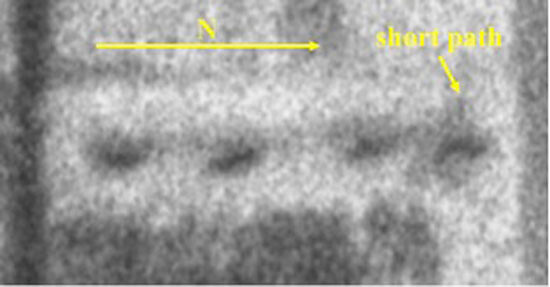
The roof of Crematorium II (Rotated 90 degrees clockwise in relation to the first image above), Auschwitz Birkenau, US Air Force, August 25, 1944. Nevin Bryant explained that the four dark areas are the Zyklon holes. He identified the short interference path next to the hole farthest to the right as a person, possibly an SS personnel, on the roof. Image courtesy of Nevin Bryant/NASA.
二号火葬场的屋顶(相对于上面第一张图片顺时针旋转90度),奥斯威辛-比克瑙,美国空军,1944年8月25日。内文-布莱恩特解释说,四个黑暗区域是齐克隆孔。他确认最右边的洞旁边的短干扰路径是一个人,可能是党卫军人员,在屋顶上。图片由Nevin Bryant/NASA提供。
Drone Warfare at the Threshold of Detectability
处于可探测阈值的无人机战争
I recalled the Van Pelt–Irving exchange about the holes when asked to undertake, through Forensic Architecture—a forensic agency of architects, artists, and filmmakers15—an investigation on drone warfare in Pakistan, Afghanistan, Yemen, Somalia, and Gaza.16 This was because many of the buildings struck by drones had a specific architectural signature to them—a small hole in their ceiling. The reason for this hole was that drone missiles, such as Hellfire or Spike, are equipped with a delay fuse. The few milliseconds between impact and detonation allow the missiles to penetrate through a roof into the room under it and spray their load of hundreds of lethal steel fragments inside. This blast of small fragments, designed to kill people but to leave the structure intact, is argued by the military to be a humanitarian munitions meant to limit casualties. Like many other techniques and technologies of “lesser evil,” this one enabled the proliferation of such strikes, thus causing more casualties.17 Seen from above, the hole in the roof is the only visible trace that the building was attacked by drones. But this hole, and the violence it evidences, are also at the threshold of detectability. This is because the size of the hole that a missile makes in a roof is smaller than that of a single pixel in the resolution to which publicly available satellite images are degraded.
当我被要求通过法证建筑--一个由建筑师、艺术家和电影制作人组成的法证机构15-对巴基斯坦、阿富汗、也门、索马里和加沙的无人机战争进行调查时,我想起了范佩尔-欧文关于这些洞的交流。出现这个洞的原因是,无人机导弹,如地狱火或尖峰,配备了延迟引信。在撞击和引爆之间的几毫秒时间里,导弹可以穿透屋顶进入屋顶下的房间,并将其装载的数百个致命的钢铁碎片喷射到里面。这种小型碎片的爆炸,旨在杀死人,但使结构保持完整,被军方认为是一种人道主义弹药。像许多其他 "较小的邪恶 "的技术和工艺一样,这种技术使这种打击扩散,从而造成更多的伤亡。17从上面看,屋顶上的洞是该建筑被无人机攻击的唯一可见痕迹。但这个洞和它所证明的暴力也是在可察觉的范围内。这是因为导弹在屋顶上打出的洞的大小,比公开的卫星图像退化后的一个像素还要小。
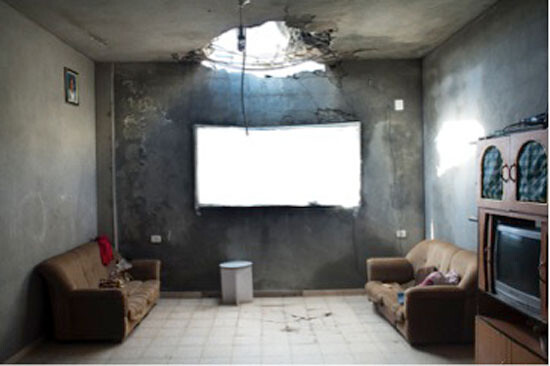
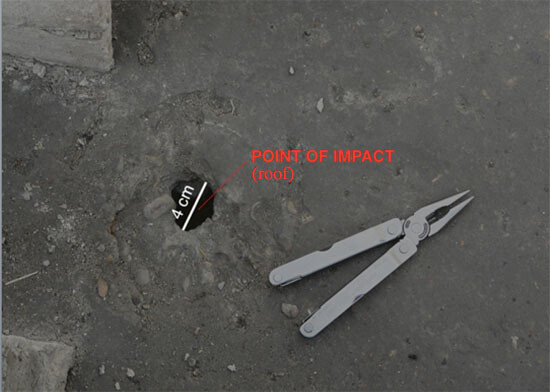
Above: Kent Klich, Tuffah, Northern Gaza, 2009. Below: A much smaller hole was recorded by Chris Cobb Smith, Gaza, 2009. Here the hole is made by a hollow charge—a stream of melted steel. Analysis by Forensic Architecture.
Until 2014, this resolution was legally kept to 50 cm/pixel, with a pixel representing half a meter by half a meter of ground.18 This resolution was legally determined because it is roughly the size of the human body when seen from above. The pixel resolution is not only a technical product of optics and data-storage capacity, but a “modulor” designed according to the dimensions of the human body. Unlike other architectural modulors (most notably that of Le Corbusier), it was not meant to help organize space, but rather to stamp the human figure out of photographs. The 50 cm resolution is useful because it bypasses risks of privacy infringement when recording people in public spaces, much in the same way that Google Street View blurs the face of people or car license plates. But the regulation also has a security rationale: it is not only important details of strategic sites that get camouflaged in the 50 cm/pixel resolution, but the consequences of violence and violations as well.19 The resolution of satellite images have direct bearing on drone attacks. Although at a resolution of 50 cm the general features of individual buildings can be identified, a hole in a roof—the signature of a drone strike—would appear as nothing more than a slight color variation, a single darker pixel, perhaps, within a pixel composition.
直到2014年,这一分辨率在法律上保持在50厘米/像素,一个像素代表半米乘半米的地面。18这一分辨率是依法确定的,因为从上面看,它大致是人体的大小。像素分辨率不仅是光学和数据存储能力的技术产品,而且是根据人体尺寸设计的 "模数"。与其他建筑模型(最值得注意的是勒-柯布西耶的模型)不同,它不是为了帮助组织空间,而是为了从照片中印出人的形象。50厘米的分辨率是有用的,因为它绕过了在公共场所记录人时侵犯隐私的风险,这与谷歌街景模糊人脸或汽车牌照的方式很相似。但这一规定也有安全方面的理由:在50厘米/像素的分辨率下,被掩盖的不仅是战略要地的重要细节,还有暴力和违法行为的后果。19 卫星图像的分辨率对无人机攻击有直接影响。虽然在50厘米的分辨率下,个别建筑物的一般特征可以被识别,但屋顶上的一个洞--无人机袭击的标志--看起来只不过是一个轻微的颜色变化,也许是一个像素组成中的一个深色像素。
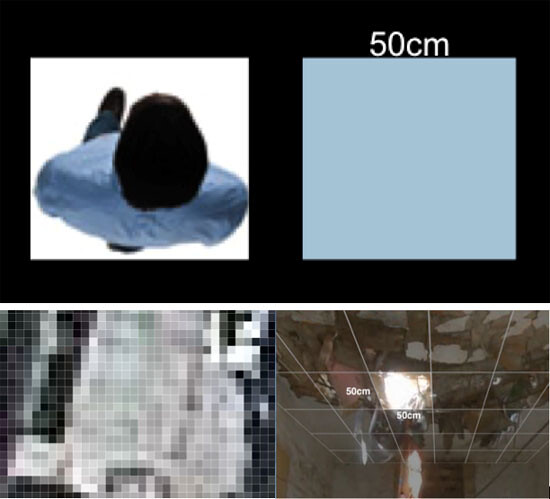
Right: A large hole in the roof of a shop in a market in Miranshah, Pakistan is left after a strike on March 30, 2012. Left: A satellite image depicts the same roof less than a day after the strike. We know this hole is in one of the pixels but cannot tell exactly which—likely one of the darker ones. Forensic Architecture, 2013.
右图。2012年3月30日,巴基斯坦Miranshah市场一家商店的屋顶在罢工后留下一个大洞。左图:在袭击发生后不到一天,一张卫星图像描绘了同一个屋顶。我们知道这个洞是在其中一个像素上,但无法准确判断是哪个像素--可能是其中一个较暗的像素。法证建筑,2013年。
The 50 cm/pixel satellite imagery thus poses a digital version of the material problem presented by the silver salt particles in the negatives of the Auschwitz aerial photographs presented in the Irving trial. It masks a hole in a roof—a hole that is similarly related in its dimensions to the human body. In both, the hole in the roof is an indication that the room under it was an assassination chamber. In both, this hole was at the threshold of detectability in the images in which it was captured. My claim is of course not that there is a relation between the Holocaust as an attempt to exterminate an entire people in gas chambers, and a secret and illegal war conducted by the US in densely populated civilian areas, but rather that the forensic-architectural problem that arises forces us to examine the material limit of images.
因此,50厘米/像素的卫星图像构成了欧文审判中提出的奥斯威辛航空照片底片中的银盐颗粒所带来的物质问题的数字版本。它掩盖了屋顶上的一个洞--这个洞在尺寸上与人体有类似的关系。在两者中,屋顶上的洞都表明它下面的房间是一个暗杀室。在这两件事中,这个洞在拍摄的图像中处于可探测的阈值。当然,我的主张并不是说大屠杀作为在毒气室中灭绝整个民族的企图,与美国在人口密集的平民区进行的秘密和非法战争之间有什么关系,而是说所产生的法医-建筑问题迫使我们审视图像的物质极限。
We do not know the precise optical specifications of drone cameras. Some operators stated publicly (or told us privately) that they could identify people. They claimed that sometimes they could even recognize them. Others said that the resolution was not sharp enough to differentiate children from adults and that they have mistaken spades for guns.20 All statements confirmed however that the human figure is the thing to which drone vision is calibrated, obviously because it is designed to deliver munitions to people and kill them. However, while the human figure is the convergent point of drone vision, it is what satellite images are designed to mask.
我们不知道无人机摄像机的精确光学规格。一些操作员公开表示(或私下告诉我们),他们可以识别人。他们声称,有时他们甚至可以认出他们。还有人说,分辨率不够清晰,无法区分儿童和成人,他们曾把黑桃误认为枪支。20 然而,所有的声明都证实,人的形象是无人机视觉所要校准的东西,显然是因为它的目的是向人运送弹药并杀死他们。然而,虽然人的形象是无人机视觉的汇聚点,但它也是卫星图像被设计为掩盖的东西。
The UN, via UNOSAT—its program delivering satellite-image analysis to relief organizations—as well as other research bodies, increasingly monitors violence by purchasing images from the archives of commercially available satellite companies. The analysis is undertaken by studying “before and after” images which are the most common form of forensic montage designed to frame an event between two spatiotemporal conditions: the “before” setting the benchmark against which the “after” state displays the result of an incident. Because satellite images render people invisible, the focus of the analysis turns to architecture, to the pairing or sequencing of buildings with ruins.
联合国通过联合国卫星项目--该项目向救援组织提供卫星图像分析--以及其他研究机构,越来越多地通过从商业卫星公司的档案中购买图像来监测暴力。这种分析是通过研究 "之前和之后 "的图像进行的,这是法医蒙太奇的最常见形式,旨在将一个事件定格在两个时空条件之间:"之前 "设定基准,"之后 "显示事件的结果。由于卫星图像使人看不见,分析的重点转向建筑,转向建筑与废墟的配对或排序。

One day before and one day after an April 29, 2012 drone strike on a former girls’ school in Miranshah, North Wasiristan, Pakistan. This is a regular method of UN investigations, but it reveals no difference. Forensic Architecture, 2013.
2012年4月29日,巴基斯坦北瓦西里斯坦省米兰沙的一所前女校遭到无人机袭击的前一天和后一天。这是联合国调查的常规方法,但却没有发现这之间有任何区别。法医建筑,2013年。
Both the act of military killing and the practice of investigating those killings are image-based practices, afforded through the combination of proximity and remoteness that is the condition of media itself. Drone strikes themselves are performed in a high-resolution designed to show information, but are monitored (by NGOs or the UN) in the poor resolution of satellite photographs designed to hide information. This fact inverts one of the foundational principles of forensics since the nineteenth century, namely, that to resolve a crime the police should be able to see more—in higher resolution, using better optics—than the perpetrator of the crime is able to. This inversion is nested in another, because in the case of drone strikes it is state agencies that are the perpetrators. The difference in vision between remote perpetrator and remote witness is the space of denial—but of a different kind than the denial presented earlier in this essay.
军事杀戮的行为和调查这些杀戮的做法都是基于图像的做法,通过媒体本身的条件,即接近和遥远的结合来提供。无人机袭击本身是以高分辨率进行的,旨在显示信息,但(由非政府组织或联合国)以低分辨率的卫星照片监测,旨在隐藏信息。这一事实颠覆了自19世纪以来法医的基本原则之一,即为了解决犯罪问题,警察应该能够看到更多--更高的分辨率,使用更好的光学设备,而不是犯罪者能够看到的。这种反转是嵌套的,因为在无人机袭击的情况下,国家机构才是犯罪者。远程犯罪者和远程目击者之间的视觉差异是否认的空间,但与本文前面介绍的否认不同。
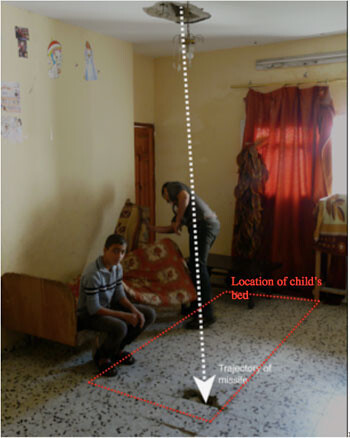
Chris Cobb Smith, Gaza, 2009. Analysis by Forensic Architecture. The boy sleeping at the time the missile hit was saved in this case.
克里斯-科布-史密斯,加沙,2009。法医建筑的分析。在这个案例中,导弹击中时正在睡觉的男孩得救了。
The formulation for denial employed by US agencies is officially sanctioned as the “Glomar response,” stating that US state agencies are authorized to “neither confirm nor deny” the existence—or nonexistence—of documents and policies such as a secret war of assassination in Pakistan. To say “this is untrue,” or “this did not happen,” is an antithesis that requires a counter narrative. Glomarization is however a form of denial that aims to add no information whatsoever. This form of denial has its corollary in the visual field through the satellite image’s inability to neither confirm nor deny the existence or nonexistence of holes in roofs that would otherwise constitute evidence of state-sanctioned violence. This form of denial is not simply rhetorical, but rather is made possible by the production of a frontier that has territorial, juridical, and visual characteristics.
美国机构采用的否认方式被官方认可为 "Glomar回应",称美国国家机构有权 "既不确认也不否认 "诸如巴基斯坦秘密暗杀战争等文件和政策的存在或不存在。说 "这是不真实的 "或 "这没有发生过 "是一种对立的说法,需要有反面的叙述。然而,Glomarization是一种否认的形式,旨在不增加任何信息。这种形式的否认在视觉领域有其必然性,因为卫星图像既不能确认也不能否认屋顶上的洞的存在或不存在,否则会构成国家认可的暴力的证据。这种形式的否认并不是简单的修辞,而是通过制造一个具有领土、司法和视觉特征的边界而成为可能。
Take for example the Waziristan region of Pakistan, since June 2004 one of the focal points for the drone campaign. Waziristan is part of the Federally Administered Tribal Areas (FATA). During the period of the British Raj, FATA was established as an extraterritorial zone of local autonomy. The Pakistani military established checkpoints that filter movement in and out; it also prevented the bringing-in and taking-out any electronic equipment, including mobile phones, cameras, and navigation equipment.21 The consequence is an effective media siege in which very few photographs and eyewitness testimonies were allowed to leave these regions. This media blackout enabled the drone warfare in these areas. It also helped Pakistani and US sources to deny this campaign ever existed and helped them to misleadingly claim that the casualties of drone strikes died rather in “bomb-making accidents.”22 In masking all signals within it, the pixel is the human-scale equivalent of the territorial-scale media blockage extended over FATA.
以巴基斯坦的瓦济里斯坦地区为例,自2004年6月以来,该地区是无人机运动的焦点之一。瓦济里斯坦是联邦直辖部落地区(FATA)的一部分。在英国统治时期,FATA是作为一个地方自治的治外法权区建立的。巴基斯坦军方设立了检查站,过滤进出;还阻止带入和带出任何电子设备,包括手机、相机和导航设备。21其结果是有效的媒体围困,很少有照片和目击者的证词被允许离开这些地区。这种媒体封锁使无人机在这些地区的战争得以进行。它还帮助巴基斯坦和美国的消息来源否认这一运动的存在,并帮助他们误导性地声称无人机袭击的伤亡者是死于 "制造炸弹的事故 "***22**在掩盖其中的所有信号时,该像素相当于在FATA地区扩展的领土规模的媒体封锁。
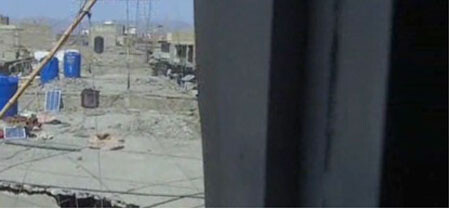

Above: The aftermath of a drone strike on March 30, 2012. MSNBC, The Rachel Maddow Show, June 29, 2012. Below: A photo-collage of dozens of still frames compose an image of a room where people died. The gaps in the pattern may represent the bodies.
上图。2012年3月30日,无人机袭击后的情景。MSNBC,Rachel Maddow秀,2012年6月29日。下图。一张由几十个静止帧组成的照片拼贴出了一个有人死亡的房间的图像。图案中的缝隙可能代表尸体。
Return to the Witness
回到证人
Facing the limitations of remote witnessing, one might turn to the testimony of survivors. I would like to present two investigations concerned with witness testimony of a different nature: the first is a video testimony shot hastily by a witness feeling him/herself to be in danger, and the second is based on the slow recollection process of a survivor of a drone strike.
面对远程见证的局限性,人们可能会转向幸存者的证言。我想介绍两项有关不同性质的证人证词的调查:第一项是由感觉自己处于危险中的证人匆忙拍摄的视频证词,第二项是基于无人机袭击的幸存者的缓慢回忆过程。
The first investigation was concerned with a close study of a video testimony shot using a handheld camera (most likely a mobile phone) in the aftermath of a March 30, 2012 drone strike in Miranshah, North Waziristan, in which four people were reportedly killed. It was a rare piece of evidence, one of very few videos documenting a site destroyed by a drone strike.23 The video had to be physically smuggled out of Waziristan, passed from hand to hand throughout several weeks, before arriving in the NBC offices in Islamabad, which broadcasted twenty-two seconds from this footage. It was one of the first recorded representations of a building being hit.
第一项调查是仔细研究2012年3月30日无人机在北瓦济里斯坦的米兰沙赫袭击后用手持摄像机(很可能是手机)拍摄的视频证词,据说有4人在这次袭击中丧生。这是一份罕见的证据,是记录被无人机袭击摧毁的地点的极少数视频之一。23 这段视频必须从瓦济里斯坦偷运出去,在几个星期内从一个人手里传到另一个人手里,然后才到达NBC在伊斯兰堡的办公室,该办公室播放了这段视频的22秒。这是对建筑物被击中的最早记录之一。
The video had two main sequences. Each of the sequences involved a different room. The first showed the damaged building from the window of a room in higher building next to it. The second was an interior sequence showing the room targeted. The first room revealed something about the videographer, and the second room revealed something about the people killed in the blast.
该视频有两个主要序列。每段视频都涉及一个不同的房间。第一段从旁边高楼的一个房间的窗户看到了被破坏的建筑。第二段是显示目标房间的内部序列。第一个房间显示了录像师的一些情况,第二个房间显示了在爆炸中死亡的人的情况。
The first sequence in the video has a large proportion of the window frame within the image frame. The window frame is not dead information; it rather makes one realize that the videographer was recording from within a certain depth inside the room, careful not to cross the window line. Every photograph records, of course, both the thing being photographed, as well as the state of the photographer.24 The concrete window frame in the image frame likely captures the videographer’s sense of danger. The videographer might be worried about being considered a spy, or about being seen by US drones still hovering overhead, or both.
视频中的第一个序列在图像框架内有很大一部分的窗框。窗框并不是死的信息;它反而让人意识到,录像师是在房间内一定的深度内进行记录,小心翼翼地不越过窗线。当然,每张照片都记录了被拍摄的事物,以及拍摄者的状态。24 图像框架中的具体窗框可能捕捉到了摄像师的危险感。摄像师可能担心被认为是间谍,或者担心被仍在头顶盘旋的美国无人机看到,或者两者都担心。
The second room captured in the video clip was the one in which the people were killed. There was a hole at the center of the ceiling through which the missile had entered. The wall is seen pockmarked with hundreds of small traces from the explosion. These are the lethal fragments in the munitions head designed to kill people. Carefully studying every video frame that captured the surface of the wall, I have noticed two distinctly shaped areas in which there are no fragments. The bodies of people in the room absorbed these fragments, leaving a peculiar “shadow” on the wall. The wall itself functioned as a photographic film. The people were exposed to the blast in a similar way in which a photographic negative is exposed to light.25 The wall as a media form connected architecture and the dead body, pathology and forensic architecture.
视频片段中拍摄的第二个房间是人们被杀的房间。天花板中央有一个洞,导弹从那里进入。可以看到墙壁上有数百个爆炸后的小痕迹。这些是弹药头中的致命碎片,旨在杀人。仔细研究每一帧拍摄到的墙壁表面的视频,我注意到两个形状明显的区域,其中没有碎片。房间里的人的身体吸收了这些碎片,在墙上留下了一个奇特的 "阴影"。墙壁本身起到了照相胶片的作用。墙作为一种媒体形式,将建筑和尸体、病理学和法医建筑联系在一起,人们被暴露在爆炸中,就像摄影底片被暴露在光线下一样。
The Architecture of Memory
回忆的建筑
The second case is based on aural testimony of a drone strike survivor. The witness is a German woman who was at her home in Mir Ali, North Waziristan, when it was hit by a drone-fired missile on October 4, 2010. She prefers to remain anonymous. The strike killed five people. After the attack, the witness returned to Germany, where she delivered her testimony to her lawyers and in the media. However, some of the details of the attack were obscured in her memory, which was interrupted by the experience of extreme violence. Many of the witnesses we work with deliver testimonies about the worst moments of their lives, days in which they lost loved ones.
第二个案例是基于一名无人机袭击幸存者的听觉证词。证人是一名德国妇女,2010年10月4日,她在北瓦济里斯坦的米尔阿里的家中被无人机发射的导弹击中。她不愿意透露姓名。这次袭击造成5人死亡。袭击发生后,证人回到德国,在那里她向她的律师和媒体提供了证词。然而,袭击的一些细节在她的记忆中被掩盖了,她的记忆被极端暴力的经历打断了。与我们合作的许多证人提供了关于他们生活中最糟糕的时刻的证词,在这些日子里他们失去了亲人。
Sitting between her lawyer and an architect acting as a computer modeler, she directed the process in which a detailed model of her house was constructed. The model included all rooms, furniture, and objects the witness could remember. Slowly, as she was sizing the rooms, locating the windows and doors, and placing mundane objects in these spaces, she started recalling and narrating fragments of memory from her life in this house and also from the strike itself. When the digital model was complete, we rendered it and undertook a series of virtual walk-throughs. “Returning” to the space and time of the strike, the witness could recount her story.26
她坐在她的律师和一名担任计算机模型师的建筑师之间,指导构建她的房子的详细模型的过程。该模型包括证人所记得的所有房间、家具和物品。慢慢地,当她确定房间的大小,确定门窗的位置,并在这些空间中放置普通物品时,她开始回忆和叙述她在这所房子里的生活以及罢工本身的记忆片段。当数字模型完成后,我们对它进行了渲染,并进行了一系列的虚拟走访。"回到 "罢工的空间和时间,证人可以重新讲述她的故事。
One object in particular was important to the witness. It was a fan. She seemed uneasy about it, repeatedly adjusting its location. At the beginning it had been modeled as a ceiling-mounted ventilator; then the witness placed it as a free-standing fan on a tripod inside a room. A few moments later she took it outside and placed it in a small courtyard that mostly served the women and children. The house was gender-segregated; most of its space was reserved for men, and women were confined to a small part within. This limited the witness optics of the events that unfolded. When “walking” through the model in the digital aftermath of the strike, she recalled finding human flesh on the fan’s blades.27 The fan was a digital object but also a vehicle into her memory. Human memory, architecture, destruction, and digital reconstruction got entangled here in a way that does not surrender to the easy separation of subject and object, testimony and evidence, matter and memory.
有一件东西对证人特别重要。那是一台风扇。她似乎对它感到不安,反复调整它的位置。一开始,它被塑造成一个安装在天花板上的通风装置;然后,证人把它作为一个独立的风扇放在一个房间里的三脚架上。过了一会儿,她把它拿到外面,放在一个主要为妇女和儿童服务的小院子里。这所房子是性别隔离的;它的大部分空间是留给男人的,而女人则被限制在里面的一小部分。这限制了对所发生的事件的见证视角。当 "走过 "罢工后的数字模型时,她记得在风扇的叶片上发现了人的肉体。人类的记忆、建筑、破坏和数字重建在这里纠缠在一起,并没有向主体和客体、证词和证据、物质和记忆的简单分离投降。
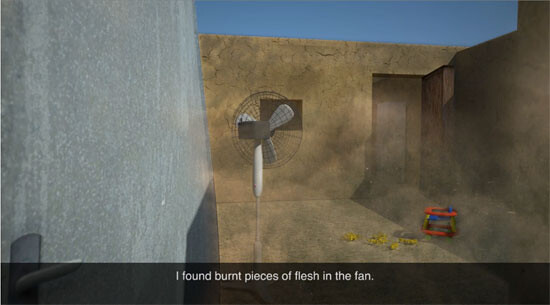
Forensic Architecture, 2013. See →
Both these investigations were based on different acts of bearing witness. They however had another important element in common: they both involved risk-taking. In order to be made public, both the witness and the video had to make an indeterminate path out of a frontier zone under military siege.28 As testimonies that involve risk and the courage to confront sovereign violence and its denial, these acts posed the most fundamental ethical and conceptual challenge to the aesthetic-political practice of forensic architecture.
这两项调查都是基于不同的见证行为。然而,它们有另一个重要的共同点:它们都涉及到风险的承担。为了公之于众,证人和视频都必须从军事围困的边境地区走出一条不确定的道路。28作为涉及风险和面对主权暴力及其否认的勇气的证词,这些行为对法医建筑的美学-政治实践提出了最基本的道德和概念挑战。
参考文献
Deborah E. Lipstadt, Denying the Holocaust: The Growing Assault on Truth and Memory (New York: Free Press, 1993).
An extended version of Van Pelt’s expert report was republished as: Robert Jan van Pelt, The Case for Auschwitz: Evidence from the Irving Trial (Bloomington: Indiana University Press, 2002). Van Pelt’s work is one of the main inspirations for Forensic Architecture.
Van Pelt, The Case, 2–3. The holes were since found; see Daniel Keren, Jamie McCarthy, and Harry W. Mazal, “The Ruins of the Gas Chambers: A Forensic Investigation of Crematoriums at Auschwitz I and Auschwitz-Birkenau” →, reproduced from Holocaust and Genocide Studies, vol. 18, no. 1, (Spring 2004): 68–103. Thanks to Patrick Kroker for this information.
David Irving v. Penguin Books, Day 11 →.
That was Robert Faurisson. Van Pelt, The Case for Auschwitz, 3ff., 24ff., and 458ff.
Keren, McCarthy, and Mazal, “The Ruins of the Gas Chambers.”
For van Pelt this “negative evidence” demonstrated the opposite: that the Nazis were covering their own traces; they were the first deniers, he explained. He stated that none of the drawings of the gas chamber showed the holes, because the architects were not allowed to draw in these pieces of incriminating evidence. In any case, the absence of evidence was certainly not evidence of an absence.
David Irving v. Penguin Books, Day 10 →.
Dino A. Brugioni and Robert G. Poirer, “The Holocaust Revisited: A Retrospective Analysis of the Auschwitz-Birkenau Extermination Complex,” February 1979 →.
Irving was referring to a 1992 study by John C. Ball. See Van Pelt, The Case, 56.
Van Pelt, The Case, 84 and 353.
David Irving v. Penguin Books, Day 11 →.
The relation between the single pixel and the human figure is a constant challenge in aerial and satellite image interpretation. The Tolimir case, one of the last of the Srebrenica cases judged at the ICTY (decided 2012, currently on appeal), has the following quote in regards to an aerial images of the Nova Kasaba soccer field. The Trial Chamber accepted the explanation of the witness on identifying darker pixels as people rather than shadows as claimed by the accused: “THE WITNESS: I have spent numerous and numerous hours analysing all these pictures and identifying what reference they can have on the ground … It’s a football field. There are no bushes in the middle. So these grey zones are not shadows. Though, indeed, a shadow has the same pixel than a group of people on the picture, but if you compare what is officially said on the photograph and the corroboration you can make of what a man represents in terms of a pixel on such a photo, this is why I allow myself to say that the dots that I have marked previously are people.” (March 29, 2010, p. 933, witness Ruez →.)
His evidence also included the interpretation of architectural plans drawn from the archive of the Auschwitz Central Construction Office, aerial photography, letters, diaries, logbooks, testimonies, and ground-level photographs. On Van Pelt’s evidence, see also: Debórah Dwork and Robert Jan van Pelt, Auschwitz, 1270 to the Present: A History (New York: W. W. Norton & Company, 2002); Robert Jan van Pelt, Architectural Principles in the Age of Historicism (New Haven: Yale University Press, 1993); and many other articles and essays.
See →.
The investigation was undertaken on behalf of various political and legal groups and was presented at the UN General Assembly in 2013 by the UN Special Rapporteur for Counter Terrorism Human Rights, Ben Emerson. The work was also presented in the context of legal action brought about by Pakistani lawyer Shahzad Akhbar in the UK Court of Appeal and in collaboration with the Bureau of Investigative Journalism (BIJ). The team was coordinated by Susan Schuppli (research and coordination), Jacob Burns (research), Steffen Krämer (video compositing and editing), Reiner Beelitz (architectural modeling), Samir Harb (architectural modeling), Zahra Hussain (research assistance), Francesco Sebregondi (research assistance), and Blake Fisher (research assistance). Some cases were undertaken in collaboration with Situ Research. Other partner organizations included the European Center for Constitutional and Human Rights (Andreas Schüller), One World Research (Bridget Prince, Nasser Arrabyee, and Anis Mansour), Al Jazeera English (Ana Naomi de Sousa), Chris Woods (freelance journalist), Edmund Clark (photographer), Chris Cobb-Smith (munitions expert and consultant), and Myra MacDonald (freelance journalist).
See Weizman, “665: The Least of All Possibl Evils," e-flux journal 38 (October 2012) →; and The Least of All Possible Evils: Humanitarian Violence from Arendt to Gaza.
The US 1998 Land Remote Sensing Policy Act. In 2014, after lobbying by satellite companies, American satellite companies were allowed to provide images in a slightly sharper a resolution—about 30 cm/pixel. They successfully argued that private identity would still be masked at this resolution. See “US lifts restrictions on more detailed satellite images,” BBC, June 16, 2014 →. The European satellite Pléiades, unaffected by the American restrictions, has since the end of 2011 provided 50 cm/pixel images of Palestine/Israel. See also Hito Steyerl’sbeautiful film How Not To Be Seen: A Fucking Didactic Educational .MOV File, 2013. The size of the pixel in relation to the size of the body makes camouflage unnecessary.
In a further radicalization of the geopolitics of resolution, US satellite image providers make an exception to the 50 cm rule in Israel and the Palestinian territories it occupies. An amendment to the US Land Remote Sensing Policy Act, which sets the permitted resolution of commercial US image satellites, dictates that these areas are shown only in a resolution of 2.5 meters (later effectively eased to 1 meter per pixel) in which a car is made of two pixels and a roof—another common target—is depicted by 6–9 pixels. The snow screen placed over Israel’s violation of Palestinian rights in the West Bank and Gaza contributed to Turkey’s decision, after the Gaza Flotilla incidents, to send its own image satellite into space and make available 50 cm/pixel images of Palestine/Israel. William Fenton, “Why Google Earth Pixelates Israel,” PCMag, June 14, 2011 → Maayan Amir, “Gaza Flotilla,” →.
Heather Linebaugh, ”I worked on the US drone program. The public should know what really goes on,” The Guardian, December 29, 2013 →.
The Federally Administered Tribal Areas are officially a “Prohibited Area” for which nonresidents require special permission to enter. A complete list of Prohibited Areas can be found here, in Annex 1 →.
Jacob Burns, “Persistent Exception: Pakistani Law and the Drone War,” in Forensis: The Architecture of Public Truth, ed. Forensic Architecture (Berlin: Sternberg Press, 2014).
Rachel Maddow, “Victims of secretive US drone strikes gain voice in Pakistani lawyer,” MSNBC, June 29, 2012 →. See also Rabih Mroué, The Pixelated Revolution, 2012.
This situation recalls the photographs secretly taken by prisoners in 1944 inside one of Auschwitz-Birkenau’s gas chambers. A large part of the image is a thick black frame—the room—because the light is calibrated to the outside. Beyond the door of the gas chamber, dead bodies are seen being burnt. Often when used in books and articles about the Holocaust, the dark frame is cropped off. In his seminal reading of these images, George Didi-Hubermann objects to this cropping because for him the frame is a crucial part of the image: not only is it the only documentation of the interior of a gas chamber, but it testifies to the mortal danger in taking this image →. Georges Didi-Huberman, Images in Spite of All: Four Photographs from Auschwitz (Chicago: University of Chicago Press, 2012).
In the same way that human bodies created voids in the ash layer over Pompeii, or that a nuclear blast famously etched a “human shadow” onto the steps outside the Sumitomo Bank in Hiroshima.
This process of mediation based on embodiment recalled other experiments in “situational awareness” undertaken in the context of US military immersive training environments and post-trauma treatment as captured in Harun Farocki’s Serious Games (2009–10).A classic predecessor to this practice is narrated in Frances Yates’ magnum opus about the Roman and medieval tradition of mnemonic techniques. The Art of Memory emphasized the relationship between memory, architecture, and destruction. Frances Yates, The Art of Memory (London: Pimlico, 1992).
Deborah Brauser, “Novel ‘Avatar Therapy’ May Silence Voices in Schizophrenia,” Medscape, July 3, 2014: “Avatar therapy allows patients to choose a digital face (or ‘avatar’) that best resembles what they picture their phantom ‘voice’ to look like. A therapist, siting in a separate room, ‘talks’ through the animated avatar shown on a computer monitor as it interacts with the patient.”
As such, both these testimonies exemplified the power of parrhesia. Michel Foucault took parrhesia to be the courage to risk one’s life in order to speak an unpopular truth. The parrhesiastes “is always less powerful than the one with whom he or she speaks. The parrhesia comes from ‘below,’ as it were, and is directed towards ‘above’ (literally) … and in its extreme form, telling the truth takes place in the ‘game’ of life or death.” Michel Foucault, Fearless Speech, trans. Joseph Pearson(New York: Semiotext(e), 2001), 15–16; and Michel Foucault, The Courage of Truth, trans. Graham Burchell (New York: Palgrave Macmillan, 2011).